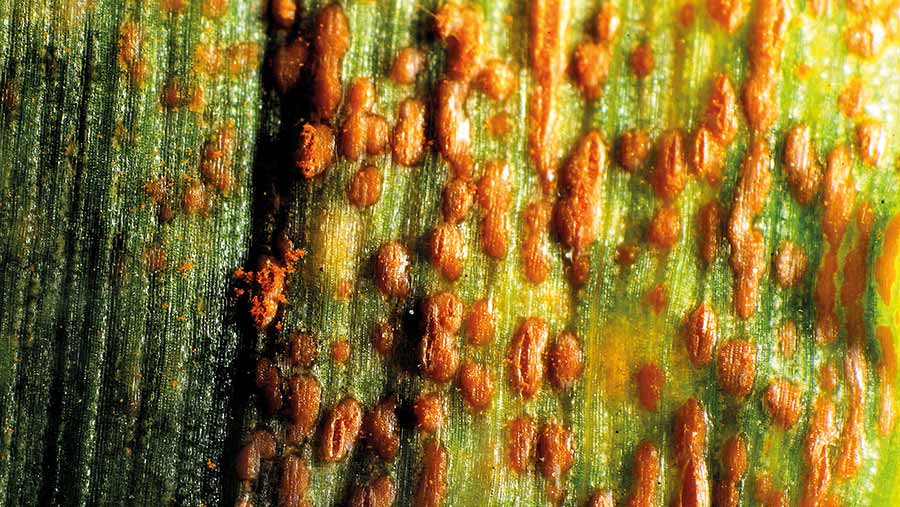What key activities does AHDB Cereals and Oilseeds provide?
 © Julian Eales/Alamy Stock Photo
© Julian Eales/Alamy Stock Photo Levy payers will be asked in April to shape AHDB’s future by giving their views on how important and valuable key tranches of the board’s work are to their businesses (see Key activities for AHDB Cereals and Oilseeds).
See also: What AHDB Cereals and Oilseeds spends its levy cash on
To set the scene, Farmers Weekly approached AHDB programme leaders to explain more about why activities in their remit are valuable for levy payers.
Key activities for AHDB Cereals and Oilseeds
- Recommended List
- Nutrient Management Guide (RB209)
- Market intelligence
- Monitoring of key pests, diseases and crop contaminants
- Control of key pests and diseases (such as fungicide performance)
- Monitor and Strategic Farm programme
- Delivery of and participation in key arable events
- Practical guidance via publications and AHDB website
1. Recommended List
Budgeted to cost £8.75m between 2021 and 2026, one of AHDB Cereals and Oilseeds’ most expensive activities, the Recommended List (RL) for cereals and oilseed rape varieties, is also perhaps the most instantly recognisable and well-used.
AHDB Recommended Lists senior manager Paul Gosling explains that its central purpose of helping growers select the right varieties for their farm is familiar, but in recent years more emphasis has been placed on making the vast amount of data more accessible to levy payers,
“Feedback from levy payers suggested they wanted easier digital access,” he says.
That has resulted in the £18,000 RL smartphone app, which has had more than 3,000 downloads despite its promotion being hampered by the pandemic.
“It’s been designed as a direct replacement of the old pocketbooks, which are expensive to produce and had a limited print run,” Mr Gosling says.
A variety selection tool has also been developed, which helps compare and select varieties most suited to a grower’s system.
Another tool uses the RL data plus parental diversity information to help growers develop wheat blends.
More trials of untreated seed are now used to help evaluate varieties’ untreated yields and, combined with disease resistance scores, are helping growers find suitable options for low-input systems.
Tweaks have also been made to how disease ratings are calculated, with more emphasis on the most recent year’s trials.
2. Market intelligence
AHDB’s weekly market and daily grain market reports provide regular information about what is driving prices or will be in the future, says David Eudall, economics and analysis director.
There are about 8,500 subscribers to the weekly report, up 6% in the past year, and 4,000 to the daily email, an increase of 14%, with open rates (a measure of the number opening or reading the messages) of above 40%.
“It’s the kind of information levy payers want. It’s up-to-date, relevant, independent, and impartial information,” Mr Eudall says.
“That doesn’t equate to neutrality – we give an opinion on what the information means and what will happen next, rather than just commentary on what has happened.”
Analysis shows that use of the reports increases when prices go up and decreases when they go down. “That’s bonkers,” he says.
“When prices are reducing it’s even more important to use the reports, because it’s when you’re losing money.”
All farmers should have a marketing plan that sets budgets and goals, he says, so they know what they are trying to achieve within the sale of their grain and understand what a price means.
“To do that takes time. The great advantage of what we do at the AHDB is to save time for the farmer. We use our time to pick out the key information and distil that down into easily understandable information.”
3. Controlling pests and diseases
A key priority is further developing integrated pest management (IPM) tactics, especially as traditional chemical control options reduce through either withdrawal or the build-up of resistance.
Jenna Watts, AHDB’s head of crop health and IPM, says: “IPM is a range of activities to manage crop protection and plant health using non-chemical control options.
Once they have been considered, pesticide inputs should be subsequently targeted according to need, through the use of decision support systems or thresholds.
“But that can be a complicated minefield of things to consider, so AHDB has summarised the principles through the mantra ‘Prevent, Detect and Control’.”
Assessing risk based on knowledge of the likely occurrence of a problem underpins the “prevent” strand.
Alongside research activities to understand weed, pest or disease targets and effectiveness of IPM control strategies, AHDB recently published a wide-ranging IPM research review that outlined different available tactics, their effectiveness, and what trade-offs might mean.

Yellow rust © Blackthorn Arable
Once the cropping season is under way, monitoring or detecting threats is critical.
“That involves crop walking but also tools that predict pest pressure and abundance, which can improve responses to an emerging threat,” Dr Watts explains.
Examples of these types of services include the UK Cereal Pathogens Virulence Survey, a project jointly funded by AHDB and Defra at a total cost of £800,914 over four years, to identify changes in rust and mildew populations, and forecasting tools such as one for sclerotinia.
Finally, when control is needed AHDB invests in helping growers understand the effectiveness of important options – for example through the fungicide performance work, which provides independent assessment of the relative performance of fungicides in wheat, barley and oilseed rape in a project costing £732,234 across four years.
4. Responding to environmental pressures
A mixture of longer-term projects and reacting to current crises is the remit of the team led by AHDB’s head of environment and resource management, Jon Foot.
In the past year that has included highlighting the need for a risk-based approach to Farming Rules for Water regulations, to ensure some organic materials can be used on land where there is an agronomic need or no risk of environmental harm.
Dr Foot says: “We’re also looking to ensure there is an evidence-based transitional timetable where, if materials are restricted, there are opportunities for derogations to enable farmers to comply through the investment of new infrastructure.”
AHDB is also developing tools to help growers demonstrate compliance, he says.
Another priority has been helping growers adjust fertiliser applications with the current high purchase costs through an easy-to-use calculator.
Longer-term projects include collaborating with Crop Health and Protection (CHAP) on a net-zero cropping report, highlighting benchmarks for greenhouse gas emissions within the sector and where there are opportunities to improve.
5. Demonstrating farm excellence
Improving farm productivity is one of the core aims of the AHDB’s Farm Excellence programme, which is centred on Strategic and Monitor Farms and discussion groups.
The four Strategic Farms focus on technical improvements, bringing research to life on the host farm and facilitating discussion about it in practice with other farmers.
The 21 Monitor Farms focus more on overall business improvement. About £300,000 has been invested annually in the programme, which has expanded greatly in recently years.
Each Monitor Farm network is also associated with an arable business group, which benchmarks performance using Farm Bench, says Graham Bannister, interim head of cereals and oilseeds knowledge exchange.
“It’s a fantastic resource, particularly for stimulating discussion about costs.”
The anonymised data set also provides insights into overall performance trends across the industry.
Annual surveys suggest these programmes are well-received by growers, with 85% of respondents saying they have made improvements to increase efficiency, 82% improving business decision-making, and 58% seeing a direct financial benefit from participating in events.
AHDB Cereals and Oilseeds future focus priorities
- Find ways for farmers to remain profitable, as production support reduces and new schemes become available
- How to protect crops and maintain yield with fewer chemicals through greater adoption of IPM approaches
- Cope with a growing demand for information on climate change and environmental performance, especially carbon, nitrogen and water
Help shape the future of farming
AHDB is asking levy payers to take part in its Shape the Future survey and help to outline the following:
- The main challenges facing their farming sector
- What work should AHDB be delivering?
- Who should be on the sector council?
Growers have until 12pm on 31 March 2022 to register to have their say. Feedback will be gathered during April.
Coming up in Part 3: Growers’ views on the priority areas where the levy should be spent

